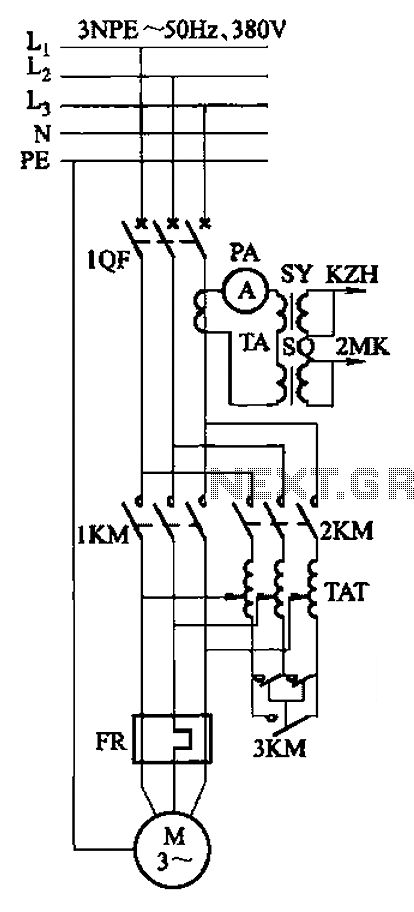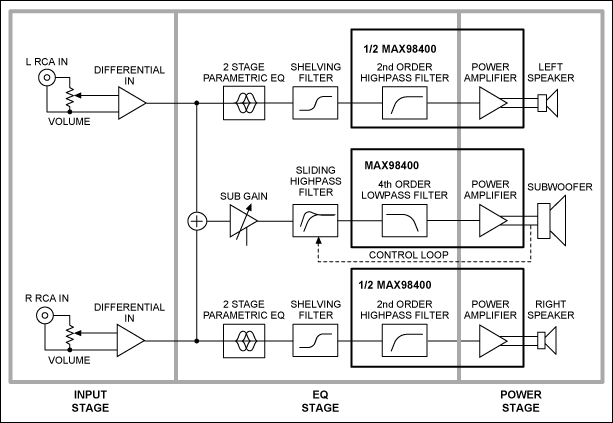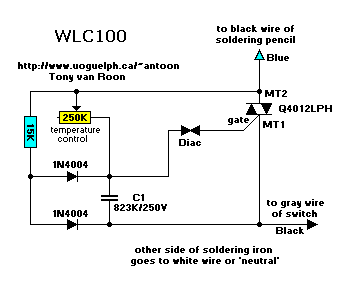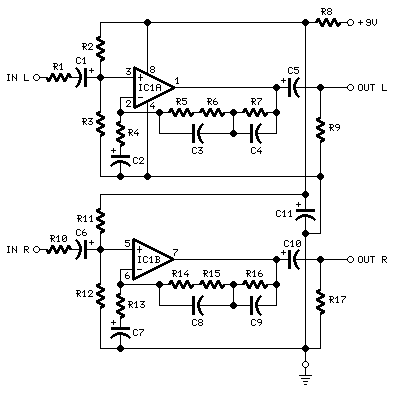
Weather station
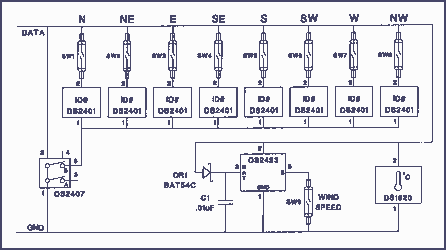


This 1-Wire MicroLAN uses a capacitor and diode half-wave rectifier to provide parasitic power from the data line for the station's various sensors and to transfer data. Each sensor has a unique serial number that identifies it to the bus. The station is controlled by a PC or microprocessor executing Touch Memory Executive (TMEX) software. Data transfers are half-duplex and bit sequential over a single twisted pair using short and long time slots to encode the binary 1s and 0s. Wind Direction Magnetically activated reed switches were selected as the wind sensors for several reasons. They do not require power to operate. Because they are neither motion nor rate dependent, they can measure static conditions. They do not require signal conditioning. And they have a very high impedance in the open state and negligible impedance when closed. The basic weather station measures wind speed and direction, ambient temperature, and rainfall totals. The package can be augmented with humidity, barometric pressure, and other weather sensors simply by connecting the sensor to the cable at the desired position and adding the appropriate software. Another option is to connect several weather stations to the same 1-Wire communication link for cost-effective measurement of laminar air flow patterns and other climatic parameters. Interestingly, reed switches are normally rated as failed or end-of-life when the on resistance of the switch reaches 1 or 2 when operated at rated power level. A reed switch can operate over 100 million or more cycles at 50 V/100 mA levels or higher before failure. 1-Wire devices, which run at 5 V/4 mA, present almost no load, however, and can work with on resistance values of up to 100. The functional lifetime of a reed switch in a 1-Wire environment such as the weather station is therefore much greater. Ongoing tests on the weather station show no degradation after more than 3 billion cycles. The wind direction sensor consists of eight reed switches mounted radially on a PCB at 22.5º intervals. Each switch is connected between the data line and a DS2401 silicon serial number that provides the switch's ID number. A rectangular activating magnet, polarized with a single pole facing the reed switch, is mounted in a rotor attached to the weather vane axle. The rotor is designed so that one layout can be used for both the wind speed and direction sensors. When the sensor is to be used for wind direction only, a single magnet is mounted in either of two holes near the rotor's center. As the wind rotates the vane and attached rotor, the magnet closes the switch as it passes over the reed.
The described 1-Wire MicroLAN system operates efficiently by utilizing a half-wave rectifier circuit composed of a diode and capacitor, enabling it to extract power from the data line. This design allows the sensors to operate with minimal power requirements, as they draw energy parasitically from the communication line. The unique serial numbering of each sensor through the DS2401 silicon serial number ensures that multiple sensors can coexist on the same bus without data collision, facilitating easy identification and communication.
The wind direction sensor's design employs eight magnetically activated reed switches, positioned at 22.5º intervals, to detect wind direction accurately. Each reed switch is connected to the data line and the DS2401, allowing for precise identification of the switch that has been activated by the magnetic field of the rotor-mounted magnet. This arrangement allows the system to determine the wind direction based on which switch is closed, thus providing a reliable measurement without the need for additional power sources or complex signal conditioning.
The use of reed switches is particularly advantageous in this application due to their high durability and low operational power requirements. With the ability to handle over 100 million cycles at higher power levels, the reed switches are well-suited for continuous operation in a weather station environment. The design ensures that the sensors can withstand extensive use without significant degradation, which is crucial for long-term monitoring applications.
The weather station's modularity enables the addition of various sensors, such as humidity and barometric pressure sensors, by simply connecting them to the existing cable infrastructure and updating the software accordingly. This flexibility allows for the customization of the weather station to meet specific monitoring needs, making it a versatile tool for environmental data collection. The ability to connect multiple stations to a single 1-Wire communication link further enhances its utility, providing a cost-effective solution for comprehensive climate monitoring across larger areas.This 1-Wire MicroLAN [1] uses a capacitor and diode half-wave rectifier to provide parasitic power from the data line for the station's various sensors and to transfer data (see Figure 1). Each sensor has a unique serial number that identifies it to the bus. The station is controlled by a PC or microprocessor executing Touch Memory Executive (TMEX) software.
Data transfers are half-duplex and bit sequential over a single twisted pair using short and long time slots to encode the binary 1s and 0s. Wind Direction Magnetically activated reed switches were selected as the wind sensors for several reasons. They do not require power to operate. Because they are neither motion nor rate dependent, they can measure static conditions. They do not require signal conditioning. And they have a very high impedance in the open state and negligible impedance (150 m) when closed. The basic weather station measures wind speed and direction, ambient temperature, and rainfall totals (see Figure 2).
The package can be augmented with humidity, barometric pressure, and other weather sensors simply by connecting the sensor to the cable at the desired position and adding the appropriate software. Another option is to connect several weather stations to the same 1-Wire communication link for cost-effective measurement of laminar air flow patterns and other climatic parameters.
Interestingly, reed switches are normally rated as failed or end-of-life when the on resistance of the switch reaches 1 or 2 when operated at rated power level. A reed switch can operate over 100 million or more cycles at 50 V/100 mA levels or higher before failure.
1-Wire devices, which run at 5 V/4 mA, present almost no load, however, and can work with on resistance values of up to 100 . The functional lifetime of a reed switch in a 1-Wire environment such as the weather station is therefore much greater.
Ongoing tests on the weather station show no degradation after more than 3 billion cycles. The wind direction sensor consists of eight reed switches mounted radially on a PCB at 22.5º intervals (see Figure 3). Each switch is connected between the data line and a DS2401 silicon serial number that provides the switch's ID number.
A rectangular activating magnet, polarized with a single pole facing the reed switch, is mounted in a rotor attached to the weather vane axle. The rotor is designed so that one layout can be used for both the wind speed and direction sensors. When the sensor is to be used for wind direction only, a single magnet is mounted in either of two holes near the rotor's center.
As the wind rotates the vane and attached rotor, the magnet closes the switch as it passes over the reed. 🔗 External reference
The described 1-Wire MicroLAN system operates efficiently by utilizing a half-wave rectifier circuit composed of a diode and capacitor, enabling it to extract power from the data line. This design allows the sensors to operate with minimal power requirements, as they draw energy parasitically from the communication line. The unique serial numbering of each sensor through the DS2401 silicon serial number ensures that multiple sensors can coexist on the same bus without data collision, facilitating easy identification and communication.
The wind direction sensor's design employs eight magnetically activated reed switches, positioned at 22.5º intervals, to detect wind direction accurately. Each reed switch is connected to the data line and the DS2401, allowing for precise identification of the switch that has been activated by the magnetic field of the rotor-mounted magnet. This arrangement allows the system to determine the wind direction based on which switch is closed, thus providing a reliable measurement without the need for additional power sources or complex signal conditioning.
The use of reed switches is particularly advantageous in this application due to their high durability and low operational power requirements. With the ability to handle over 100 million cycles at higher power levels, the reed switches are well-suited for continuous operation in a weather station environment. The design ensures that the sensors can withstand extensive use without significant degradation, which is crucial for long-term monitoring applications.
The weather station's modularity enables the addition of various sensors, such as humidity and barometric pressure sensors, by simply connecting them to the existing cable infrastructure and updating the software accordingly. This flexibility allows for the customization of the weather station to meet specific monitoring needs, making it a versatile tool for environmental data collection. The ability to connect multiple stations to a single 1-Wire communication link further enhances its utility, providing a cost-effective solution for comprehensive climate monitoring across larger areas.This 1-Wire MicroLAN [1] uses a capacitor and diode half-wave rectifier to provide parasitic power from the data line for the station's various sensors and to transfer data (see Figure 1). Each sensor has a unique serial number that identifies it to the bus. The station is controlled by a PC or microprocessor executing Touch Memory Executive (TMEX) software.
Data transfers are half-duplex and bit sequential over a single twisted pair using short and long time slots to encode the binary 1s and 0s. Wind Direction Magnetically activated reed switches were selected as the wind sensors for several reasons. They do not require power to operate. Because they are neither motion nor rate dependent, they can measure static conditions. They do not require signal conditioning. And they have a very high impedance in the open state and negligible impedance (150 m) when closed. The basic weather station measures wind speed and direction, ambient temperature, and rainfall totals (see Figure 2).
The package can be augmented with humidity, barometric pressure, and other weather sensors simply by connecting the sensor to the cable at the desired position and adding the appropriate software. Another option is to connect several weather stations to the same 1-Wire communication link for cost-effective measurement of laminar air flow patterns and other climatic parameters.
Interestingly, reed switches are normally rated as failed or end-of-life when the on resistance of the switch reaches 1 or 2 when operated at rated power level. A reed switch can operate over 100 million or more cycles at 50 V/100 mA levels or higher before failure.
1-Wire devices, which run at 5 V/4 mA, present almost no load, however, and can work with on resistance values of up to 100 . The functional lifetime of a reed switch in a 1-Wire environment such as the weather station is therefore much greater.
Ongoing tests on the weather station show no degradation after more than 3 billion cycles. The wind direction sensor consists of eight reed switches mounted radially on a PCB at 22.5º intervals (see Figure 3). Each switch is connected between the data line and a DS2401 silicon serial number that provides the switch's ID number.
A rectangular activating magnet, polarized with a single pole facing the reed switch, is mounted in a rotor attached to the weather vane axle. The rotor is designed so that one layout can be used for both the wind speed and direction sensors. When the sensor is to be used for wind direction only, a single magnet is mounted in either of two holes near the rotor's center.
As the wind rotates the vane and attached rotor, the magnet closes the switch as it passes over the reed. 🔗 External reference
